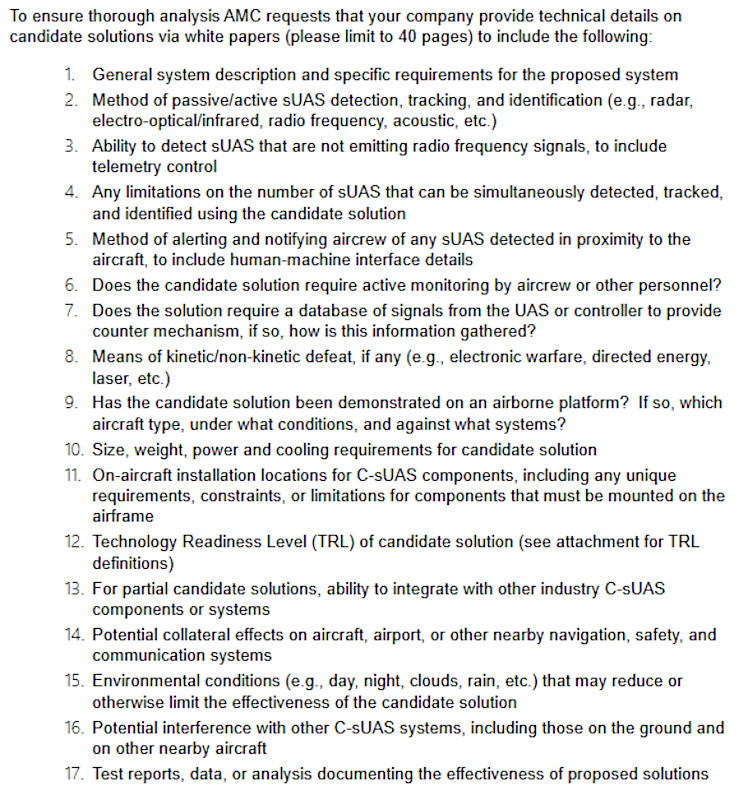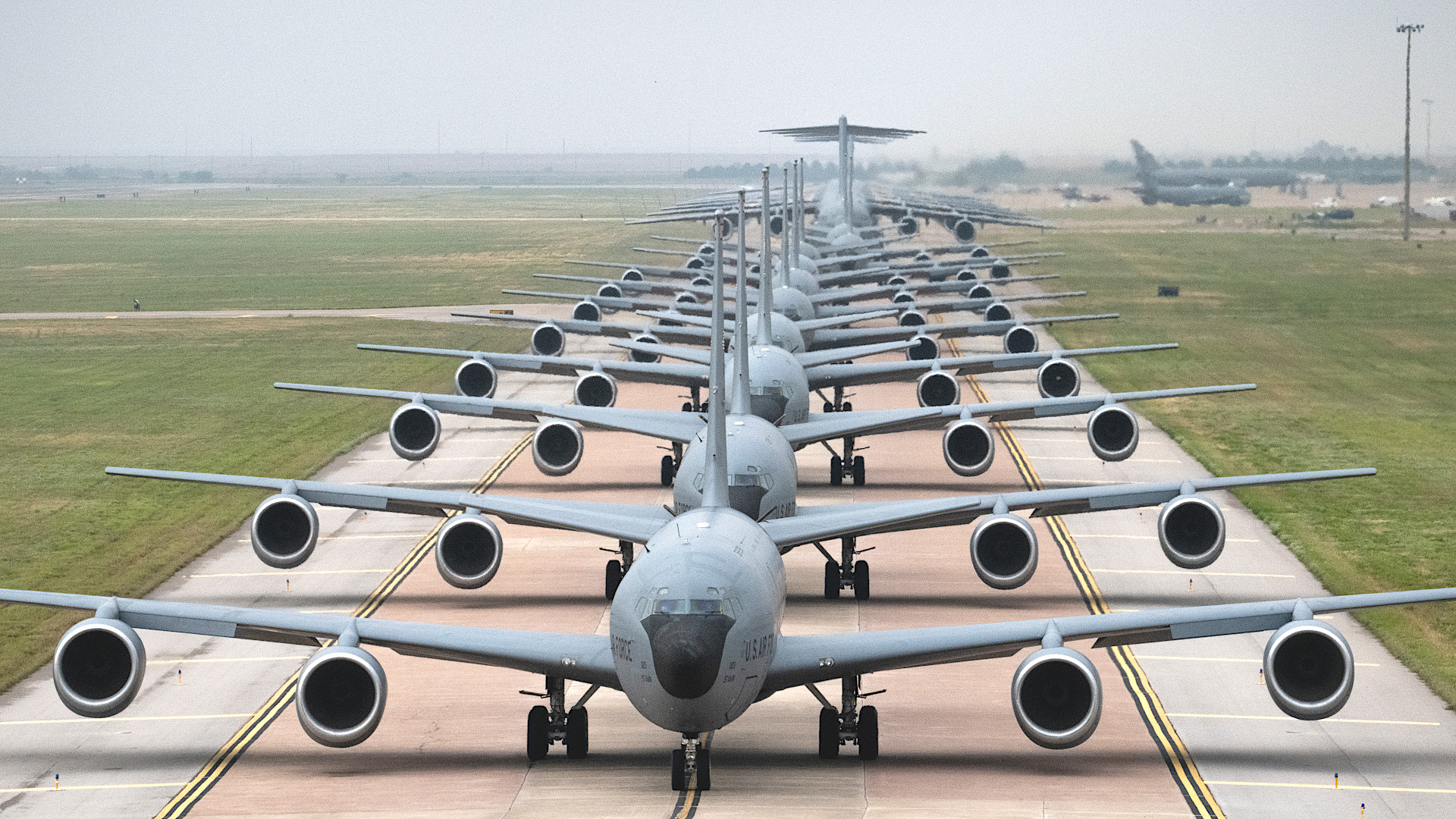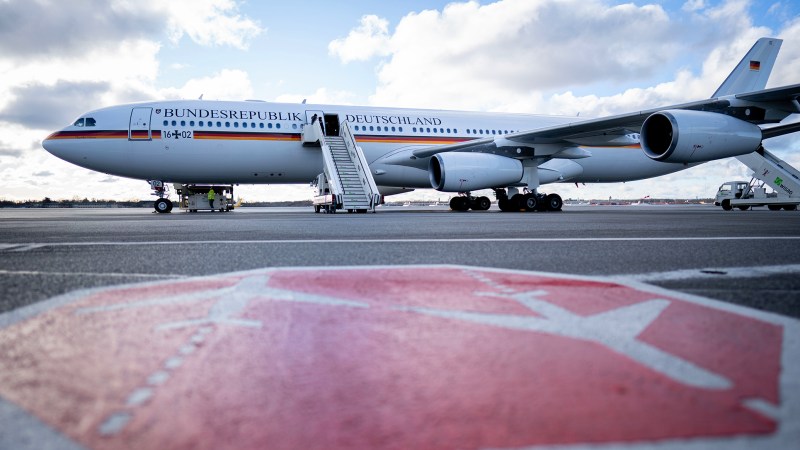The U.S. Air Force’s Air Mobility Command (AMC) is currently taking pitches for ways to add new defenses directly onto its airlifters, tankers, and executive passenger planes to protect against drones attacking or surveilling them while in the air and on the ground. The risks that uncrewed aerial systems, even commercial types that can be readily weaponized, pose to aircraft, especially out in the open on the ground, is something The War Zone has been calling attention to for years now.
Drones have fully emerged as a scourge on modern battlefields and present particular threats to aircraft parked on airfield flight lines, as underscored by a Ukrainian attack targeting Su-57 Felon advanced combat jets at a base deep inside Russia earlier this month. That ongoing fighting in that country has made clear that even smaller uncrewed aerial systems, especially weaponized first-person view types turned into kamikaze drones, can be extremely dangerous to aircraft, tanks, and other traditional military hardware.

At the same time, drones are becoming increasingly ubiquitous worldwide and present ever-growing risks to aircraft conducting routine day-to-day operations well outside the context of traditional conflicts. A prime example of this was the repeated drone incidents over Langley Air Force Base in Virginia, a major East Coast air defense hub that hosts F-22 Raptor stealth fighters, for weeks last year, which The War Zone was the first to report on in March.
AMC recently put out its Request For Information (RFI) notice asking for details about possible “On-Aircraft Counter-Small Unmanned Aircraft System” options. The threshold for “small” in this case is at least Group 1 and 2 uncrewed aerial systems (UAS), but the goal is for the new defensive systems to be effective against Group 3 types, as well. Collectively, per the U.S. military’s definitions, drones in the first two categories can have maximum weights of up to 55 pounds, fly up to altitudes of 3,500 feet, and have top speeds of up to 250 knots. The third tier represents a major step up capability-wise, encompassing drones that tip the scales at up to 1,320 pounds and can get up to 18,000 feet, but again with speeds of 250 knots or less.
The RFI is not limited to any particular aircraft types, but does mention the C-17A Globemaster III and C-130 Hercules as examples of platforms that could receive the new anti-drone defenses. The C-17 and C-130 are among AMC’s most heavily utilized cargo planes, but the command oversees the vast majority of the Air Force’s airlift, tanker, and passenger aircraft fleets, including the pair of VC-25A Air Force One presidential jets.

There are also no specific stipulations about how the system has to function at a core level. Dedicated counter-drone systems on the market or known to be in development today generally use some combination of sensors, such as electro-optical and/or infrared cameras and small radar arrays, to spot and track targets. Passive electronic support measures systems are another especially common means of detecting threats. Those sensors are then also used to cue whatever the system’s effectors might be, which could include electronic warfare jammers, high-power laser and microwave directed energy weapons, various kinds of surface-to-air interceptors, traditional guns, or even other drones.
It’s worth mentioning here that laser weapons continue to present serious challenges for use on aircraft, as you can read more about here. Small active electronically scanned array (AESA) radars could also notably be an option for both detection and some form of electronic warfare attack.
AMC really has only two hard requirements at this point in the information-gathering process, according to the RFI.
Firstly, “AMC is interested in information on concepts and technologies that… represent full or partial on-aircraft C-sUAS [counter-small uncrewed aerial systems] capability solutions,” according to the Request For Information (RFI) notice. “Partial capability solutions could include those that only satisfy a sub-set of the desired C-sUAS functions (e.g., only detect, track, and identify sUAS; no defeat); or are otherwise limited (e.g., operable only in-flight or during certain environmental conditions).”
The “concepts and technologies” in question also have to “have been demonstrated on an airborne platform or have been used on other mobile platforms (e.g., ground vehicle), with the potential for future integration onboard an airborne platform with additional development.”
It is worth noting that the aircraft in AMCs fleets already have varying degrees of self-protection capabilities or the ability to be fitted with them when deployed. These can include arrays of warning sensors tied to dispensers for decoy flares and radar-blinding chaff, as well as directional infrared countermeasures (DIRCM) systems that use lasers to throw off heat-seeking missiles. There have been discussions in the past about adding new hard-kill defenses, which could utilize physical interceptors or directed energy weapons, to U.S. military transport and tanker aircraft, ostensibly aimed at defeating incoming missiles. New on-aircraft counter-drone defenses might well leverage those developments or otherwise be integrated into existing defensive suites.

There are still questions about exactly how new anti-drone defenses on AMC might actually work, especially systems designed to work in flight, and how time-consuming and costly it might be to install those capabilities. Existing counter-drone systems can often be bulky and not optimized for integration into an airframe.
With this in mind, AMC does want whatever proposals it gets to provide answers to a host of specific questions. This includes things like is the system able “to detect sUAS that are not emitting radio frequency signals, to include telemetry control” and “does the solution require a database of signals from the UAS or controller to provide counter mechanism, if so, how is this information gathered?” The full list of points any submission has to address is reproduced below.

The RFI’s definition of “on-aircraft” also notably encompasses systems that could be rolled on and off specifically to provide added counter-drone defense on the ground at a deployed location. AMC says it will consider options that a single individual or a small team could operate in a forward-deployed context, as well.
That being said, “roll-on/roll-off kits… need to be small enough to not displace cargo weight or size and be ready within seconds without significant loadmaster effort,” AMC notes. “Traditional, full-sized C-UAS vehicles displace too much cargo.”

In addition, any “hand-carried systems” need to be capable of being “set up quickly by crew members (not the 20–30-minute set-ups that current “portable” systems require).”
A built-in system could be useable in the air and on the ground, at least in part, which would be advantageous. Even just having extra capabilities for detecting drones in both contexts would give crews valuable additional situational awareness about potential threats, which is the most pressing issue over outright threat defeat. This is where existing missile approach warning sensors on AMC aircraft or new distributed aperture systems could be particularly useful, for providing alerts and some form of cueing, at least on a basic level to start.
It is not uncommon for an RFI like this to be open-ended to try to solicit a broad array of possible options for addressing a problem set. If AMC’s requirements, so far, are broad, the threat picture it is staring down is far more well-defined and clear-cut. The command attached a detailed, if still ostensibly notional concept of operations (CONOPS) that lays out why new on-aircraft counter-drone capabilities are not just desirable, but of increasingly critical importance.
AMC’s “mission is to provide global air mobility throughout the full spectrum of military operations, from peacetime to combat. This includes worldwide rapid global mobility and delivery of military equipment and personnel, air refueling, aeromedical evacuation, humanitarian relief, and distinguished visitor transportation, to include Presidential movement,” the CONOPS document explains. As such, the command’s “aircraft operate in and out of U.S. military airfields, foreign military airfields, international airports, regional airports, and even unimproved landing zones.”

On top of that, “in general, AMC aircraft are large aircraft that operate at slower speeds and are not highly maneuverable” and unless they “are operating in and out of U.S. military airfields, they rely on the security provided by the local airfield, which may be civilian controlled or completely uncontrolled.”
“UAS may be encountered everywhere, and the likelihood of encounter is increasing with the rapid development of small, inexpensive drones,” the CONOPS adds, noting that AMC “is concerned with both individual drone operations, as well as drone swarms.”
In terms of drone threats to aircraft in the air, AMC highlights landing and takeoff as being points where its already slower and less agile fleets are particularly vulnerable. Aircraft, in general, have less room ability to maneuver and are flying at lower speeds and altitudes at the beginning and ends of their flights, increasing the dangers posed by a variety of different threats. There have been particular concerns over the years about the dangers shoulder-fired surface-to-air missiles, also known as man-portable air defense systems (MANPADS), pose to commercial, as well as military aircraft in exactly the same contexts.
AMC aircraft are also often called upon to operate more broadly at altitudes below 16,000 feet, such as during airdrops or certain kinds of aerial refueling missions, where certain lower-tier drones can reach them.

On, the ground, AMC’s aircraft, often full of fuel and cargo, are far more vulnerable. The War Zone has highlighted many times in the past how planes parked in the open, where airlifters generally are when they are loaded and unloaded, present easier and very enticing targets for an adversary. Even using commercially available drone technology, an opponent could use such an opportunity to damage or destroy large numbers of aircraft even before they get into the fight. This could happen at home or during forward operations.
Even well-established air bases in the United States still often lack sufficient defenses against drones, as well as other threats. Despite uncrewed aerial systems posing very real threats for years now, the U.S. military continues to very much be playing catchup when it comes to counter-drone capabilities. In May, Air Force officials at Seymour Johnson Air Force Base in North Carolina put their own RFI regarding possible new anti-drone shelters at that base, underscoring this reality. A larger debate is raging now within the Department of Defense, and between it and Congress, over the best way to shield airfields and other bases against drones and other threats, as you read more about here.
In an actual conflict scenario, especially a high-end fight like one in the Pacific against China, AMC’s aircraft would also be dispersed to or otherwise called upon to operate from remote and austere locations, including impromptu dirt airstrips or even roads. What kind of defenses might be available at those sites could well be limited or non-existent. This only heightens the importance of having on-aircraft options that AMC’s planes could bring in with them.

These issues extend to operations outside of an immediate conflict, including routine flights in and out of civilian airports, which are outside of the U.S. military’s direct control and where it may have limited, if any authority to dictate changes to existing security measures. Local laws and regulations, as well as other concerns about collateral impacts, may present additional limitations on what kind of on-aircraft capabilities AMC’s aircraft can employ in a variety of non-combat scenarios.
“During humanitarian operations, friendly drones may be in use to assess damage, provide surveillance, or deliver aid. It would be counter-productive to defeat these drones, so systems deploying some type of friendly drone detection with discernment not to attack blue drones would be beneficial,” the CONOPS accompanying AMC’s counter-drone RFI notes. “Likewise, at commercial airports, counter UAS capabilities must be compatible with airport navigation aids, traffic control radars, and communication systems both for airport and air traffic. For example, systems can’t broadly jam/spoof GPS or kinetic kill potential threats if the Vice President’s plane is sitting on a ramp at Frankfurt International Airport.”

This raises another important point that drones that are not explicitly hostile can still present hazards. Commercial and private individual use of various tiers of uncrewed aerial systems has been steadily growing for years now, and legal structures in the United States and elsewhere have been slow to catch up. Instances of ostensibly benign drone activity being a danger to routine military and civilian air traffic alike are increasing.
“An onboard drone detection system that alerts aircrew to the presence of drones and provide drone location and numbers is a desired capability to enhance flight safety. A capability with similar functionality as a Traffic Collision and Avoidance System (TCAS) to visually display drone locations to allow aircrew to avoid the threat,” the CONOPS document notes. “Additionally, an onboard counter drone capability which could mitigate hazards to flight operations is highly desired. Since crews are task-saturated during these flight profiles, the system should require very minimal crew interaction to detect and defeat the threat/hazard UAS.”
Furthermore, the rapid proliferation of lower-tier drone technology has also lowered the barrier to entry for even small and often non-state actors, including terrorists and drug cartels, to turn commercial drone technology into a threat. Rapidly discriminating between a non-hostile drone and one that is about to attack or is otherwise engaged in some kind of malign activity is already proving to be extremely difficult. This will only become more of a challenge as both battlefields and non-combat environments become more and more saturated with drones.
Altogether, “AMC requires effective options that don’t involve significant prior ground support, can effectively defend against future drone threats, and can operate in civilian peacetime environments,” according to the CONOPS.
It remains to be seen what combination of new on-aircraft counter-drone capabilities AMC might pursue or when any such systems might be fielded. Any capabilities that do make it onto the command’s aircraft could find their way onto platforms elsewhere within the U>S. military, too. The final date for submissions in response to the RFI is August 28.
What is clear from AMC’s contracting notice is that its fleets have critical needs for added layers of protection against drones that they can take wherever they might go.
Contact the editor: tyler@twz.com
























